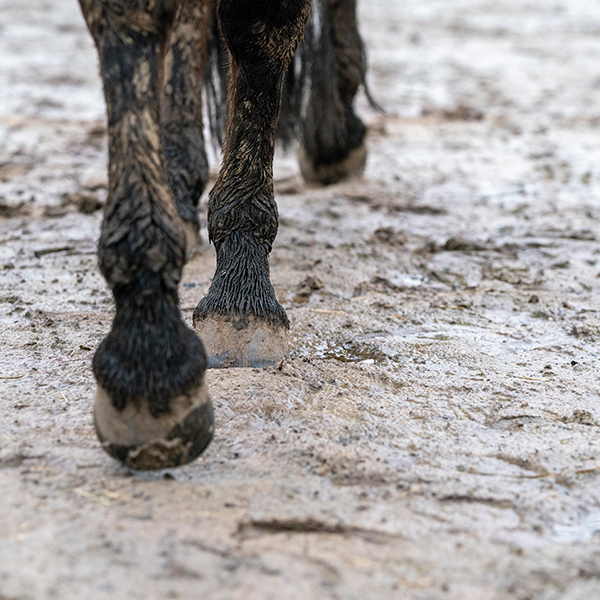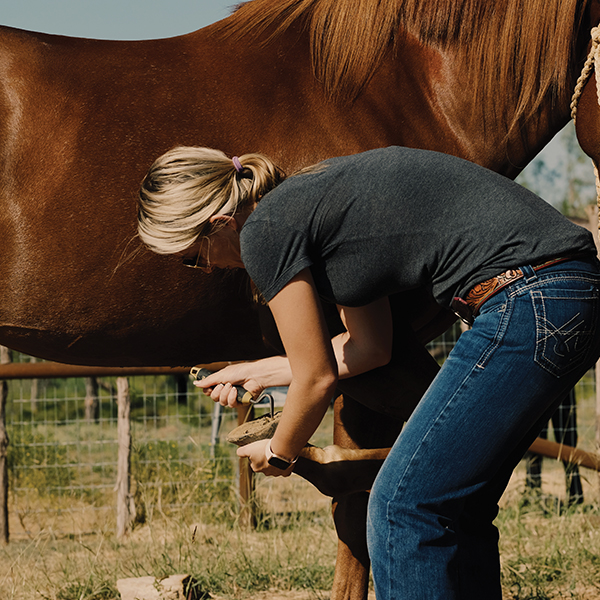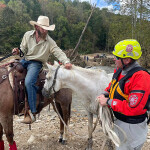As you lift your horse’s hoof, a familiar scent wafts up, revealing the unmistakable black goo that every horse owner dreads: thrush. This condition is notably prevalent during the wet months and can pose significant health risks if not treated effectively and consistently.
What is “Thrush”?
Thrush is an inflammation of the fleshy frog portion of a horse’s hoof, primarily affecting the center and grooves (central and lateral sulci) of the frog. However, it can also impact the heel and deep cracks between the heel bulbs. Various bacterial and fungal strains can cause thrush, with Fusobacterium necrophorum being the most common bacterial culprit. This condition typically arises when horses are kept in damp, muddy or unclean environments, as such conditions create an ideal breeding ground for bacteria and fungi to flourish.
Thrush is characterized by a dark coloration and a distinctive odor reminiscent of a dirty, damp, or sweaty articles of clothes. It is often compared to athlete’s foot, as both conditions are caused by fungal and/or bacterial pathogens. Common signs of thrush include hoof tenderness, pain, softened frogs, and lameness.
Fortunately, thrush is easily preventable through daily hoof cleaning, proper farrier care, and ensuring that horses are housed in dry, clean environments. If left untreated or inadequately treated, thrush can lead to permanent lameness, and the infection may spread to other areas of the horse’s lower extremities.

Treatment
When detected early, treating thrush is straightforward, typically resolving within seven to 14 days. Effective treatment involves the removal of dead tissue by a farrier or veterinarian. Once the dead tissue is cleared, it’s crucial to treat the hooves with an iodine solution to eliminate microorganisms, accompanied by daily cleaning and soaking. It is important to note that iodine solutions stronger than 2% are very caustic and should not be used.
Use a hoof pick to remove any debris, followed by a gentle cleanse using a soft brush (such as a clean paintbrush) or cotton swabs soaked in diluted iodine or another antiseptic solution. Soaking the hoof in a diluted iodine solution or other antiseptic/anti-fungal solution for approximately 30 minutes each day can be highly productive. After soaking, ensure the hoof is thoroughly dried using clean swabs.
Your veterinarian or farrier may recommend bandaging the hoof between soaks until new frog tissue regenerates. To keep the area clean, pack the frog cleft with cotton soaked in a disinfectant solution, and have your horse wear a hoof boot. Additionally, your veterinarian or farrier might prescribe a topical ointment, which should be applied to the frog area only after it has been thoroughly cleaned.
If you horse’s thrush is not improving with treatment or lameness worsens, contact your veterinarian immediately. Again, thrush can develop into serious and permanent lameness if neglected. Horses can even develop swelling in the lower limb if the infection becomes severe enough.

Thrush Prevention
Thrush is largely preventable with effective management practices. Horses should be housed in clean, dry shelters and stalls. Regular stall cleaning and the removal of wet spots on a daily basis are crucial for maintaining cleanliness. The wet conditions of fall and winter can pose challenges, especially for horses that are turned out around the clock. To manage thrush in muddy and damp pastures, it is advisable to clean hooves daily and apply thrush-specific solutions that help seal moisture out of vulnerable areas around and on the frog of the hoof.
To effectively manage thrush, it’s important to evaluate the efficiency of your pasture shelters and the drainage systems in heavily trafficked areas. Shelters should have a minimum of three sides to keep moisture out. Regularly cleaning these shelters—ideally on a daily or weekly basis—to remove wet debris and waste is crucial. Proper drainage is essential to divert water away from shelters and gates, preventing the formation of standing water and mud. To minimize mud and stagnant water, consider filling these areas with gravel. Using geotextile fabric or crushed asphalt underneath can enhance drainage. The gravel should be pea-sized and laid to a depth of about four inches to create a well-draining area in the pasture that effectively manages excess moisture.
A key preventative measure in horse care is the daily cleaning and inspection of your horse’s hooves. Remove any debris, dirt, rocks, and excess moisture from all hooves while also checking for signs of abscesses and white line disease, which can arise from pathogens entering the hoof tissues.
Ensure your horse stays current with farrier appointments every four to six weeks, as shorter intervals help catch hoof issues earlier. The farrier should trim the hooves to prevent the development of long heels and deep sulci.

Conclusions
Thrush is a common condition in horses, but it can be effectively treated if addressed promptly. It’s important not to underestimate its seriousness, as inadequate treatment can lead to more severe issues. If you have any questions regarding the treatment and management of thrush, please feel free to reach out to your veterinarian, farrier or county’s Extension office.
Kyla Szemplinski, MS, is an Extension Agent I and 4-H Agricenter Youth Development for UT TSU Shelby County Extension. She serves Shelby County, Tennessee equine community, and can be contacted at the Shelby County office at 901-752-1207 during normal business hours Monday-Friday 8am-4:30pm CST.










